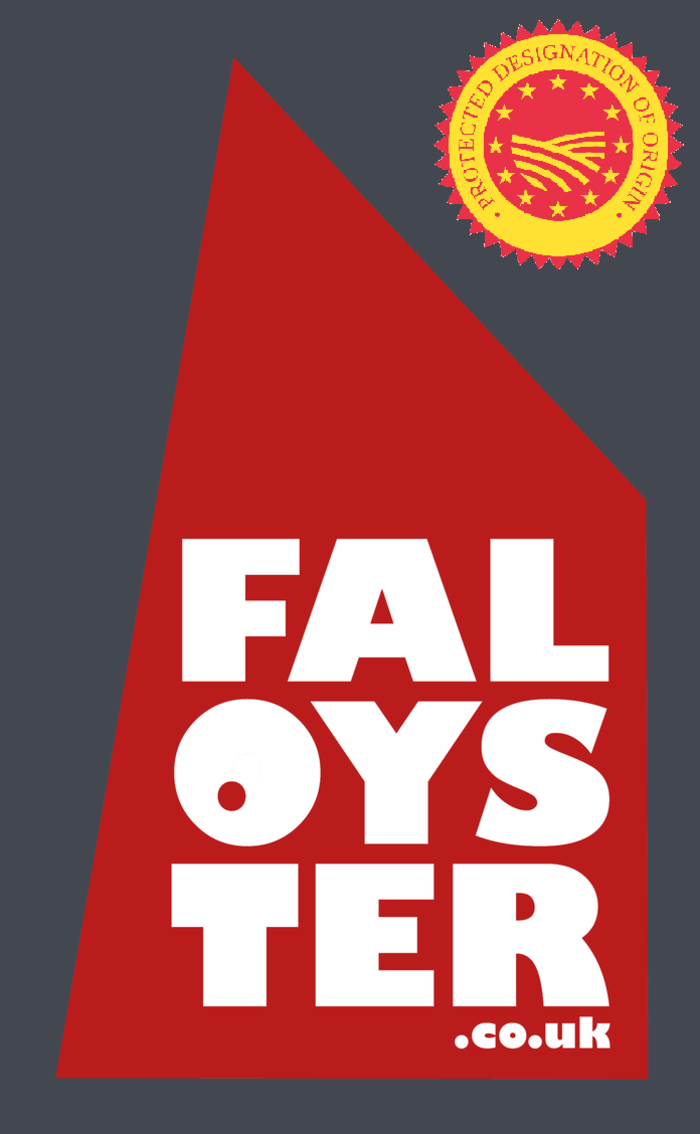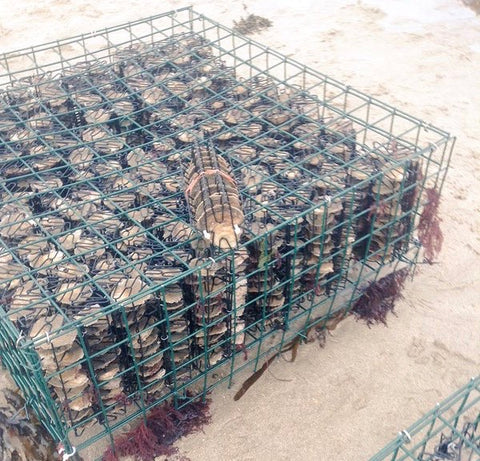#SavingESTER The Oyster February 01 2020
Saving 'Ester' - Cornish for 'Oyster'!
A Wild Cornish Native Oyster Hatchery - Crowdfunder Pitch
If you are just browsing or short of time right now, please just read the bold text OR look at the pictures showing growth stages AND sign up to our newsletter! EVEN THE SMALLEST DONATION WILL MAKE A REAL DIFFERENCE TO THE SURVIVAL OF THIS SPECIES, JUST £1 WILL SAVE ONE ESTER - A CORNISH NATIVE OYSTER!
Native Oyster Larvae Stages
Copyright: Rodriguez-Perez, A., Sanderson, W. G., Møller, L. F., Henry, T. B. & James, M. (2020). Return to sender: the influence of larval behaviour on the distribution and settlement of the European oyster Ostrea edulis.
(Manuscript submitted for publication.)
WE AIM TO HATCH AND RELEASE 1,000,000 CORNISH NATIVE OYSTERS IN TO THE FAL ESTUARY, CROWDFUNDING IS THE ONLY WAY WE CAN KICK START THIS PROJECT IN 2020
We will save large disease resilient Cornish Native Oysters and put them through a controlled hatchery program, so we can study the growth patterns of larvae & spat (baby oysters), then they will go through natural seawater settling and holding tanks, as well as upwellers and silos, TO ENCOURAGE AN INCREASE IN THE SURVIVAL RATE OF WILD NATIVE OYSTERS...
…"SEAFISH current survival rate for larvae to 12 months old in the wild is 1/500,000 or 0.0002%".
The project has very low expectations of just a 1% survival rate, however it is well understood in the USA that a 30%-60% survival rate can be achieved with hatchery born and nursery managed stocks. Also when mature oysters are stored at a density with many male & female oysters they will all help to trigger male oysters, when fertilized with billions of eggs created in the female shell they release millions of larvae in to their wild natural habitat, the Fal Estuary.

Oyster 'pediveliger spat' on a Queen Scallop Shell
The Fal Fishery Cooperative CIC is a ‘not for profit’ organisation, but like all other charities and community interest companies it has to cover overhead costs of administration, rent, research, staff and stock with or without grants/funding, it also has to build itself towards being a fair employer and sustainable habitat manager for the years, decades and centuries to come.
The director has recently co-authored two papers: European Native Oyster Restoration Policy (for peer review) and European Native Oyster Restoration Handbook (in prep)
Participating Contributor to:
Native Oyster Network UK & Ireland,
Native Oyster Restoration Alliance (NORA).
Research Centres:
Bangor University's Shellfish Research Centre.
Project Contractors:
National Lobster Hatchery Padstow,
Fal Oyster t/a Cornish Native Oysters,
Jersey Sea Farms.
If not us who, if not now when?
WHY IS THIS PROJECT SO IMPORTANT?
The Native Oyster Restoration Alliance (NORA) and the Berlin Oyster Recommendation: “bringing back a key ecosystem engineer by developing and supporting best practice in Europe” Bernadette Pogoda et al "Recommendations: Produce sufficient oysters for restoration of oyster reefs Background: Sufficient seed oyster supply is a key limiting factor for native oyster restoration projects in Europe. Translocation between sites of seed oysters or any other size classes from wild beds should be discouraged to avoid increasing the pressure on still existing wild beds and reduce the risk of spreading invasive species and disease. Recommendation: Action should be undertaken to support existing hatcheries, spatting ponds and spat collector techniques and to establish new hatcheries and spatting ponds for the production of robust and genetically diverse Ostrea edulis seed. Brood stock sanctuaries should be established and used for local reinforcements."
Native Oyster Tray Microreefs
Copyright Jersey Sea Farms Ltd
ENVIRONMENTAL SERVICES
Oysters play a vital role in filtering seawater and keeping marine habitats alive, just one oyster can filter over 200 litres almost 50 gallons every day, clean seawater also helps with photosynthesis, which in turn helps marine plant species!
It goes without saying that there is “No Planet B!” it has taken thousands and thousands of years for the Oyster to acclimatise and to be crowned as one of the longest serving edible seafoods. There is evidence primates have been using stone tools to eat shellfish for millennia, yet human overfishing, pollution and disease has wiped out 85-95% of the Native Oyster population in the past 2 decades alone. Overfishing juveniles before they have reproduced, unnecessary pollution into our estuaries and seas and eliminating the spread of diseased stock by screening, are all things we can change today by scientifically supported research and sustainable aquaculture.
Cornish Native Oyster Tray Growth, Depurated Fal Oysters
Copyright CJ Ranger
ECONOMIC VIABILITY
Historically, about 100 years ago, some 200 vessels landed 800 tonnes from the same 1100 hectares that is now managed under the Fal Fishery Regulatory Order 2016, unfortunately the relaying on the Fal Estuary of European Oyster seed in the 1950-60s wiped out indigenous English Native Oysters throughout the UK with a disease called Bonamia. A disease still found but one we hope to overcome. Stocks have recovered and maybe the offspring’s have become more resilient, but in the past few decades landings have peaked at about 100 tonnes between a few dozen or so vessels seen fishing on a daily basis. In 2019-20 season it is estimated that less than 20 tonnes will be harvested from less than a dozen vessels. Hundreds of families were probably yielding more revenue over a century ago than the majority of the fleet of sailing vessels that are barely earning a living today. By putting a million 1year old spat (baby native oysters) back in to the Fal Estuary every year we will be "putting more on than are taken off for relaying and consumption".
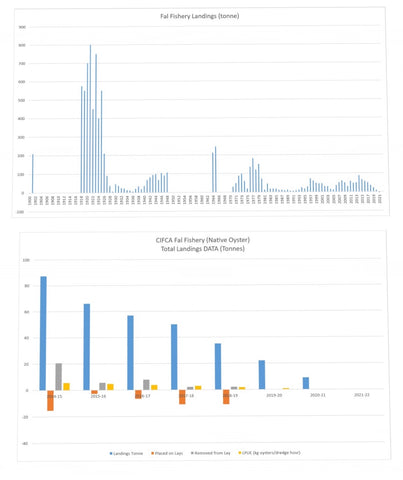
Lower Chart shows 'Actual Fishery Landings' blue columns 1-5 and 'Trending Estimated Landings' blue columns 6-7... so given the trends the 2020-21 season could be last for the sailing fleet and at what point will the biomass tipping point never recover?...
The long term problem with fishing out all the 2-3yr old juveniles, is they barely reach maturity (where the take one leave but more than one theory should exist) in their own natural habitat, so its an ever decreasing biomass. (“It’s been shown that systematic predation causes prey of smaller size” says Nathaniel Dominy of Dartmouth College in Hanover, New Hampshire)
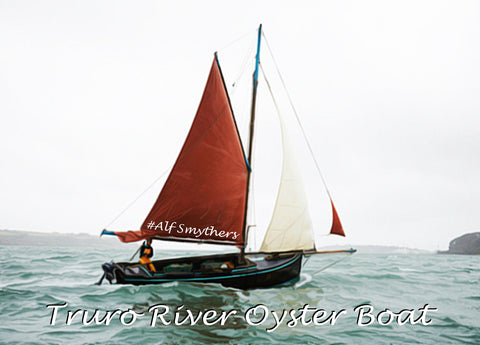
Truro River Oyster Boat 'Alf Smythers'
Artwork Copyright CJ Ranger
SOCIAL COMMUNITY
Heritage on the River Fal Fishery is believed to go back to the Phoenicians and Roman times and has been documented for more than 400 years – Sir Richard Carew wrote in 1602 of fishermen casting a “thick strong net fastened to three spills of iron and drawn to the boats stern, gathering whatsoever it meeteth lying in the bottom of the water, out of which when it taken up, they cull the oyster”. We need to provide for the future generations, not leave them with very few options to survive on...
The current problem is the 'effort or kg per dredge hour' shown by LPUE (yellow) in chart above is less than 1kg of native oysters per hand hauled dredge, per hour... 2 hand dredges, 6 hours = 12kg @ £3.80 = £45.60 per day as a solo skipper of a 8m sailing fishing vessel during the winter months... … So the numbers of vessels and crews drop off and the ground gets more and more silted up creating 'dead zones' with little or no marine life at all!
It now seems ever so destructive to tow for 20m and only get one native oyster!...
HOW CAN YOU HELP?
Even a donation of just £10 (and by sharing your pledge with everyone you know so they might donate too) will show us and many others how much you care about our environment (planet), economy (pounds) and social community (people), so we can all play a part and restore what was once a sustainable and efficient industry. Whether you enjoy eating oysters or whether you just want cleaner seas and a diverse marine ecosystem, by supporting this project you will help oysters that are a backbone species that improve habitat and encourage many other plant and animal species to flourish.
Even greater pledges/donations or corporate sponsorship and becoming a Patron* will help us build the project quicker, so we can hopefully influence regulators and policy makers to listen to the future scientific evidence, that will reverse the decline in stocks, provide not just a sustainable food resource, but more importantly a healthier habitat and living wage for the future generations of children and grandchildren that will ultimately inherit our only planet.

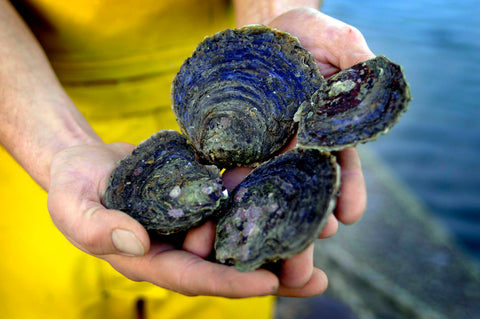
The CIC Director holding Cornish Native Oysters 2010
Copyright Mike Thomas
REWARDS FOR YOUR PLEDGES...
15-33% of your pledges will be spent on your rewards if you choose to collect them 67-85% of your pledges will be used to deliver the project if you choose to collect your rewards 100% of your donation will be used in the project if you prefer just to donate
The merchandise rewards (T Shirts, Hats, Aprons etc - see reward options) will be hand screen printed (by CIC) and locally embroidered so you can show off your support to others, you will be contacted for sizes before we order!
Genuine Fal Oysters that have been gathered by hand, sail and oar in the 2019-20 season OR for later rewards in 2020-21 season when they have been through the new crowd funded hatchery and nursery program.
*BRONZE, SILVER & GOLD PATRONS will be invited to play a part in the whole process, from fishery trips to grading & processing oysters, from taking part in the hatchery process to helping relocate the spat to the nursery area... WE WILL ALSO INVITE YOU TO ONE OF OUR OYSTER SHUCKING MASTERCLASSES AND OFFER DISCOUNTS ON PRIVATE FUNCTIONS SUCH AS OUR WEDDING OYSTERS BARS... If you wish to get further involved you may also be invited to become a subscriber, board member or director of the CIC.
At the final weekend of this 8 week pitch Steve Skinner will be hosting our fundraiser finale to celebrate the 10th birthday of Pop Up Gatherings at the Skinners Brewery Tap known as the Old Ale House in Truro with Sushi Master Goemon from Dinings Harcourt Street London (W1H 4HH) with bands on Friday & Saturday evening and Rosie Crow headlining Sunday afternoons British Summer Time Special (Thursday 26th to Sunday 29th March 2020).
STRETCH TARGETS...
We hope to reach the 1st Spring Target (above) within a matter of weeks as the target secures the first summers hatchery program. The 2nd Summer Target (below) is to secure the aquaculture site for a year ahead, the 3rd Autumn Target (below) is required to secure the moorings and infrastructure to store the hatchery stock once it has settled and grown to a size that can be placed in to the wild nursery, the 4th huge Winter Target is to purchase a grader, and year 2 rent, so scientific research data can be collected and used as evidence to encourage better fishery regulations, therefore prevent the overfishing of juveniles you have helped us to create.
WE CANNOT CONTINUE TO TAKE FROM THE ENVIRONMENT WITHOUT PUTTING SOMETHING BACK, AND WE CANNOT KICK START A HATCHERY PROGRAM WITHOUT SUPPORT AND FUNDING FROM YOU, THE CROWD! We may follow this pitch with other crowdfunding pitches if we don't reach our stretch targets. So please donate and spread the word to your own friends and families.
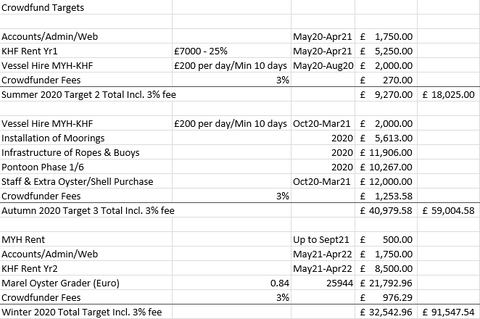
We then aim to fund scientific research in best practices in aquaculture, help responsibly manage hatchery & nursery stocks, support markets for a new generation of skippers & crew. Then, when the oysters have reproduced many times, a sustainable yield of 80-125g Cornish Native Oysters will be gathered and only when depurated by verified processors do they become prestigious PDO Fal Oysters with real provenance.
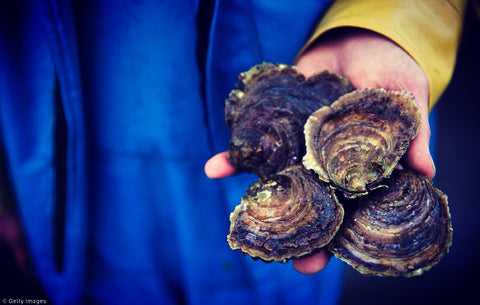
The Director holding Cornish Native 'Fal Oysters' 2016
Copyright Getty Images
SUPPORTING SCIENTIFIC EVIDENCE...
A 2yr old can produce 500,000 larvae and only 1 might survive 12 months, a 4yr old can produce 1,000,000 larvae and 2 might survive, but after 4 years 1+1+2=4 might be left after harvesting compared to maybe none left after harvesting a 2yr old!!
· 85-95% of the worlds population of European Native Oysters have been lost due to overfishing, disease and pollution - we aim to use what stock is left on the Fal Fishery to kick start a restoration program...
· The Principle Scientific Officer for the Fal Fishery Regulatory Authority stated "I fear we might be at a density of native oysters (1 per 20m2) that would make successful reproduction incredibly difficult" - we aim to store hatchery produced stock and legal juveniles too small to eat in a biomass greater than 5m2...
· There is only one UK hatchery, yet there are already 7 restoration projects in the UK alone that are struggling to source disease free native oyster seed - with a 1% fertilization and 67% survival each year we aim to create A MILLION 40-80g juveniles in year 2-3 from our local hatchery...
· IF YOU ARE INTERESTED IN THE SCIENCE THERE IS A LOT MORE DETAIL ABOUT OUR PROJECT AND TO STAY INFORMED...
Sign up to our Mailchimp Newsletter by clicking here
Follow us and find out more: www.falfisherycoopcic.co.uk
A HUGE THANK YOU FOR TAKING THE TIME TO READ THIS AND HOPE IT MAKES SENSE #SavingESTER !
Saving 'Ester' - A Cornish Native Oyster!
A Wild Cornish Native Oyster Hatchery
If you are just browsing or short of time right now, please just read the bold text and sign up to our newsletter!
WE AIM TO HATCH AND RELEASE 1,000,000 CORNISH NATIVE OYSTERS IN TO THE FAL ESTUARY, CROWDFUNDING IS THE ONLY WAY WE CAN KICK START THIS PROJECT IN 2020
EVEN THE SMALLEST DONATION WILL MAKE A REAL DIFFERENCE TO THE SURVIVAL OF THIS SPECIES, JUST A POUND WILL SAVE AN ESTER - A CORNISH NATIVE OYSTER!
We will save larger disease resilient Cornish Native Oysters and put them through a controlled hatchery program so we can study the growth patterns of larvae & spat (baby oysters) through settling and holding tanks, as well as floating upwellers and eventually natural seawater silos TO ENCOURAGE AN INCREASE IN THE SURVIVAL RATE OF WILD NATIVE OYSTERS...
…"SEAFISH current survival rate for larvae to 12 months old in the wild is 1/500,000 or 0.0002%".
The project has very low expectations of just a 1% survival rate, however it is well understood in the USA that a 30%-60% survival rate can be achieved with hatchery born and nursery managed stocks. Also when stored at a density with many male & female oysters they will all help to trigger male oysters, when fertilized with billions of eggs created in the females this releases millions of larvae in to their wild natural habitat, the Fal Estuary.
Oyster 'spat' on a Queen Scallop Shell showing the importance of 'cultch' - Copyright CJ Ranger
Sign up to our Mailchimp Newsletter by clicking here
Follow us and find out more: www.falfisherycoopcic.co.uk
The Fal Fishery Cooperative CIC is a ‘not for profit’ organisation, but like all other charities and community interest companies it has to cover overhead costs of administration, rent, research, staff and stock with or without grants/funding, it also has to build itself towards being a fair employer and sustainable habitat manager for the years, decades and centuries to come.
The director has recently co-authored two papers: European Native Oyster Restoration Policy (for peer review) and European Native Oyster Restoration Handbook (in prep)
Project partners include: Native Oyster Network UK & Ireland, Native Oyster Restoration Alliance (NORA), Bangor University's Shellfish Research Centre, Marine I at University of Exeter Penryn Campus, Fal Oyster t/a Cornish Native Oysters, Jersey Sea Farms and the National Lobster Hatchery Padstow.
If not us who, if not now when?
WHY IS THIS PROJECT SO IMPORTANT?
The Native Oyster Restoration Alliance (NORA) and the Berlin Oyster Recommendation: “bringing back a key ecosystem engineer by developing and supporting best practice in Europe” Bernadette Pogoda et al "Recommendations: Produce sufficient oysters for restoration of oyster reefs Background: Sufficient seed oyster supply is a key limiting factor for native oyster restoration projects in Europe. Translocation between sites of seed oysters or any other size classes from wild beds should be discouraged to avoid increasing the pressure on still existing wild beds and reduce the risk of spreading invasive species and disease. Recommendation: Action should be undertaken to support existing hatcheries, spatting ponds and spat collector techniques and to establish new hatcheries and spatting ponds for the production of robust and genetically diverse Ostrea edulis seed. Brood stock sanctuaries should be established and used for local reinforcements."
Native Oyster Tray Microreefs - Copyright Jersey Sea Farms Ltd
ENVIRONMENTAL SERVICES
Oysters play a vital role in filtering seawater and keeping marine habitats alive, just one oyster can filter over 200 litres almost 50 gallons every day, clean seawater also helps with photosynthesis, which in turn helps marine plant species!
It goes without saying that there is “No Planet B!” it has taken thousands and thousands of years for the Oyster to acclimatise and to be crowned as one of the longest serving edible seafoods. There is evidence primates have been using stone tools to eat shellfish for millennia, yet human overfishing, pollution and disease has wiped out 85-95% of the Native Oyster population in the past 2 decades alone. Overfishing juveniles before they have reproduced, unnecessary pollution into our estuaries and seas and eliminating the spread of diseased stock by screening, are all things we can change today by scientifically supported research and sustainable aquaculture.
Cornish Native Oyster Tray Growth, Depurated Fal Oysters - Copyright CJ Ranger
ECONOMIC VIABILITY
Historically, about 100 years ago, some 200 vessels landed 800 tonnes from the same 1100 hectares that is now managed under the Fal Fishery Regulatory Order 2016, unfortunately the importation of European Oyster seed in the 1950-60s wiped out indigenous English Native Oysters throughout the UK with a disease called Bonamia. Stocks have recovered and maybe the offspring’s have become more resilient, but in the past few decades landings have peaked at about 100 tonnes between a few dozen or so vessels seen fishing on a daily basis. In 2019-20 season it is estimated that less than 20 tonnes will be harvested from less than a dozen vessels. Hundreds of families were probably yielding more revenue over a century ago than the majority of the fleet of sailing vessels that are barely earning a living today. By putting a million 1year old spat (baby native oysters) back in to the Fal Estuary every year we will be "putting more on than are taken off for relaying and consumption".
Chart shows 'Actual Fishery Landings' blue columns 1-5 and 'Trending Estimated Landings' blue columns 6-7... so given the trends the 2020-21 season could be last for the sailing fleet and at what point will the biomass tipping point never recover?... The long term problem with fishing out all the 2-3yr old juveniles, is they barely reach maturity (where the take one leave but more than one theory should exist) in their own natural habitat, so its an ever decreasing biomass. (“It’s been shown that systematic predation causes prey of smaller size” says Nathaniel Dominy of Dartmouth College in Hanover, New Hampshire)
Truro River Oyster Boat 'Alf Smythers' - Artwork Copyright CJ Ranger
SOCIAL COMMUNITY
Heritage on the River Fal Fishery is believed to go back to the Phoenicians and Roman times and has been documented for more than 400 years – Sir Richard Carew wrote in 1602 of fishermen casting a “thick strong net fastened to three spills of iron and drawn to the boats stern, gathering whatsoever it meeteth lying in the bottom of the water, out of which when it taken up, they cull the oyster”. We need to provide for the future generations, not leave them with very few options to survive on...
The current problem is the 'effort' shown by LPUE in chart above is less than 1kg of native oysters per hand hauled dredge, per hour... 2 hand dredges, 6 hours = 12kg @ £3.80 = £45.60 per day as a solo skipper of a 8m sailing fishing vessel during the winter months... So the numbers of vessels and crews drop off and the ground gets more and more silted up creating 'dead zones' with little or no marine life at all!
HOW CAN YOU HELP?
Even a donation of just £10 (and by sharing your pledge with everyone you know so they might donate too) will show us and many others how much you care about our environment (planet), economy (pounds) and social community (people), so we can all play a part and restore what was once a sustainable and efficient industry. Whether you enjoy eating oysters or whether you just want cleaner seas and a diverse marine ecosystem, by supporting this project you will help oysters that are a backbone species that improve habitat and encourage many other plant and animal species to flourish.
Even greater pledges/donations or corporate sponsorship and becoming a Patron* will help us build the project quicker, so we can hopefully influence regulators and policy makers to listen to the future scientific evidence, that will reverse the decline in stocks, provide not just a sustainable food resource, but more importantly a healthier habitat and living wage for the future generations of children and grandchildren that will ultimately inherit our only planet.
The Director holding Cornish Native Oysters 2010 - Copyright Mike Thomas
REWARDS FOR YOUR PLEDGES...
15-33% of your pledges will be spent on your rewards if you choose to collect them 67-85% of your pledges will be used to deliver the project if you choose to collect your rewards 100% of your donation will be used in the project if you prefer just to donate
The merchandise rewards (T Shirts, Hats, Aprons etc - see reward options) will be hand screen printed (by CIC) and locally embroidered so you can show off your support to others
Genuine Fal Oysters that have been gathered by hand, sail and oar in the 2019-20 season OR for later rewards in 2020-21 season when they have been through the new crowd funded hatchery and nursery program.
*BRONZE, SILVER & GOLD PATRONS will be invited to play a part in the whole process, from fishery trips to grading & processing oysters, from taking part in the hatchery process to helping relocate the spat to the nursery area... If you wish to get further involved you could also be invited to become a subscriber, board member or director of the CIC.
At the final weekend of this 8 week pitch Steve Skinner will be hosting our fundraiser finale to celebrate the 10th birthday of Pop Up Gatherings at the Skinners Brewery Tap known as the Old Ale House in Truro with Sushi Master Goemon from Dinings Harcourt Street London (W1H 4HH) with bands on Friday & Saturday evening and Rosie Crow headlining Sunday afternoons British Summer Time Special (Thursday 26th to Sunday 29th March 2020).
STRETCH TARGETS...
We hope to reach the 1st Spring Target (above) within a matter of weeks as the target secures the first summers hatchery program. The 2nd Summer Target (below) is to secure the aquaculture site for a year ahead, the 3rd Autumn Target (below) is required to secure the moorings and infrastructure to store the hatchery stock once it has settled and grown to a size that can be placed in to the wild nursery, the 4th huge Winter Target is to purchase a grader, and year 2 rent, so scientific research data can be collected and used as evidence to encourage better fishery regulations and therefore prevent the overfishing of juveniles you have helped us to create.
WE CANNOT CONTINUE TO TAKE FROM THE ENVIRONMENT WITHOUT PUTTING SOMETHING BACK, AND WE CANNOT KICK START A HATCHERY PROGRAM WITHOUT SUPPORT AND FUNDING FROM YOU, THE CROWD!
We may follow this pitch with other crowdfunding pitches if we don't reach our stretch targets. So please donate and spread the word to your own friends and families.
We then aim to fund scientific research in best practices in aquaculture, help responsibly manage hatchery & nursery stocks, support markets for a new generation of skippers & crew. Then, when they have reproduced many times, a sustainable yield of 80-125g Cornish Native Oysters will be gathered and only when depurated by verified processors do they become PDO Fal Oysters. Only then can they be enjoyed as truly sustainable ‘Fruits of the Sea’ with a prestigious Protected Designation of Origin provenance, for centuries to come!
The Director holding Cornish Native 'Fal Oysters' 2016 - Copyright Getty Images
SUPPORTING SCIENTIFIC EVIDENCE...
A 2yr old can produce 500,000 larvae and only 1 might survive 12 months, a 4yr old can produce 1,000,000 larvae and 2 might survive, but after 4 years 1+1+2=4 might be left after harvesting compared to maybe none left after harvesting a 2yr old!!
· 85-95% of the worlds population of European Native Oysters have been lost due to overfishing, disease and pollution - we aim to use what stock is left on the Fal Fishery to kick start a restoration program...
· The Principle Scientific Officer for the Fal Fishery Regulatory Authority stated "I fear we might be at a density of native oysters (1 per 20m2) that would make successful reproduction incredibly difficult" - we aim to store hatchery produced stock and legal juveniles too small to eat in a biomass greater than 5m2...
· There is only one UK hatchery, yet there are already 7 restoration projects in the UK alone that are struggling to source disease free native oyster seed - with a 1% fertilization and 67% survival each year we aim to create A MILLION 40-80g juveniles in year 2-3 from our local hatchery...
· IF YOU ARE INTERESTED IN THE SCIENCE THERE IS A LOT MORE DETAIL ABOUT OUR PROJECT AND TO STAY INFORMED...
Sign up to our Mailchimp Newsletter by clicking here
Follow us and find out more: www.falfisherycoopcic.co.uk
A HUGE THANK YOU !
